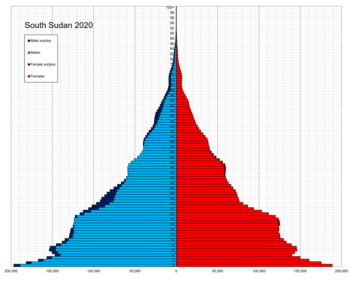
Back التركيبة السكانية في جنوب السودان Arabic Насельніцтва Паўднёвага Судана Byelorussian Demografia del Sudan del Sud Catalan Demografía de Sudán del Sur Spanish Démographie du Soudan du Sud French სამხრეთ სუდანის დემოგრაფია Georgian 남수단의 인구 Korean Demografi Sudan Selatan Malay Demografia do Sudão do Sul Portuguese Stanovništvo Južnog Sudana Serbo-Croatian
| Demographics of South Sudan | |
|---|---|
 Population pyramid of South Sudan in 2020 | |
| Population | 11,544,905 (2022 est.) |
| Growth rate | 4.91% (2022 est.) |
| Birth rate | 37.69 births/1,000 population (2022 est.) |
| Death rate | 9.52 deaths/1,000 population (2022 est.) |
| Life expectancy | 59.16 years |
| • male | 57.43 years |
| • female | 60.97 years |
| Fertility rate | 5.32 children born/woman (2022 est.) |
| Infant mortality rate | 63.18 deaths/1,000 live births |
| Net migration rate | 20.97 migrant(s)/1,000 population (2022 est.) |
| Age structure | |
| 0–14 years | 41.58% |
| 65 and over | 2.53% |
| Nationality | |
| Nationality | South Sudanese |
| Language | |
| Official | English, Arabic |

South Sudan is home to around 60 indigenous ethnic groups and 80 linguistic partitions among a 2021 population of around 11 million[1][2]. Historically, most ethnic groups were lacking in formal Western political institutions, with land held by the community and elders acting as problem solvers and adjudicators. Today, most ethnic groups still embrace a cattle culture in which livestock is the main measure of wealth and used for bride wealth.
The majority of the ethnic groups in South Sudan are of African heritage who practice either Christianity or syncretisms of Christian and Traditional African religion. There is a significant minority of people, primarily tribes of Arab heritage, who practice Islam. Most tribes of African heritage have at least one clan that has embraced Islam, and some clans of tribes of Arab heritage have embraced Christianity.
Linguistic diversity is much greater in the southern half of the country, a significant majority of the people belong to either the Dinka people (25.2%) of the South Sudan population, and primary residents of the historic Upper Nile Region and Bahr el Ghazal Region or the Nuer people (18.6%) of the South Sudan population living primarily in the historic Greater Upper Nile region along with a significant number of Dinka. Both peoples speak one of the Nilo-Saharan languages and are closely related linguistically. Sixty four languages are standard language in South Sudan; however, their dialects are not all mutually intelligible.
Historically, neither the Dinka nor the Nuer or any other tribes have a tradition of centralized political authority and embrace a cattle culture where land is held by the community and livestock is the main measure of wealth. It is common to conduct cattle raids against neighbors. The tribes are fragmented into clans of politically separate communities with customs against intermarriage among clans. Processes of urbanization are a source of significant cultural change and societal conflict.
- ^ "World Population Prospects 2022". United Nations Department of Economic and Social Affairs, Population Division. Retrieved 17 July 2022.
- ^ "World Population Prospects 2022: Demographic indicators by region, subregion and country, annually for 1950-2100" (XSLX) ("Total Population, as of 1 July (thousands)"). United Nations Department of Economic and Social Affairs, Population Division. Retrieved 17 July 2022.
© MMXXIII Rich X Search. We shall prevail. All rights reserved. Rich X Search